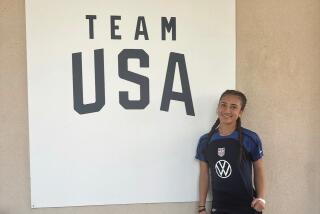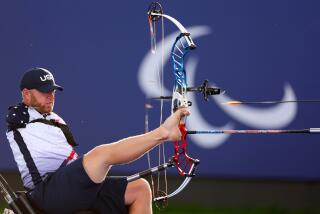ORANGE : Big Strides for Athlete Amputees
- Share via
To survive losing a limb, the secret is to keep your head, amputee Dennis Oehler told youngsters at Children’s Hospital of Orange County on Friday.
“Ninety percent of what you’re going to do in later life comes from here,” Oehler said, pointing to his head.
Oehler, who won a gold medal for the 400-meter sprint at the 1992 Paralympics Games in Barcelona, was at CHOC with four other amputee athletes to tell children coping with severe disabilities that life not only goes on after trauma, it sometimes gets better.
Santa Barbara native Casey Pieretti offered himself as a prime example of that. The 28-year-old, who lost a leg in a traffic accident when he was a teen-ager, has crossed the country on in-line skates, visited more than 500 high schools with a team of skaters and demonstrated his skills at NBA halftime shows.
“When I was 19, I was playing college basketball,” he told patients who had just watched him skate-jump over a 6-foot-high stack of barrels. “Now I’m with the NBA doing slam-dunks in front of 20,000 people.”
Pieretti, Oehler and the other athletes, in town for an amputee training clinic at Cal State Dominguez Hills this weekend, attribute their success to their determination to overcome their disabilities and to great strides in the technology of prosthetic limbs.
Thomas Bourgeois, a 27-year-old Texas native who lost his leg as an infant, grew up playing sports with his three brothers but was slowed by the weight of an old-style artificial leg. The development in the 1980s of flexible spring legs enabled him and other amputees to set their goals nearly as high as those of two-legged athletes.
“To be able to run on this leg is just indescribable,” Bourgeois said. “You almost wish you had two artificial legs.”
The athletes are in training now for the 1996 Paralympics, scheduled in Atlanta two weeks after the regular Olympic games. Kurt Collier, a 29-year-old Tucson resident who works as a certified prosthetist, hopes to compete in the triathlon.
Collier lost his leg five years ago after being struck by a car while bicycling. While he was hospitalized, he read a Sports Illustrated story about disabled athlete Jim McLaren and decided to follow his example. Now he and McLaren compete in the same events, Collier said, and are good friends.
“I feel fortunate just to be here,” Collier said. “I learned to do things differently. At the same time, I learned that different can be better.”
More to Read
Sign up for Essential California
The most important California stories and recommendations in your inbox every morning.
You may occasionally receive promotional content from the Los Angeles Times.













